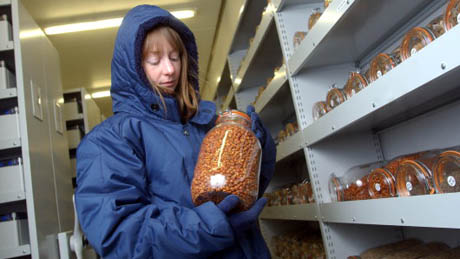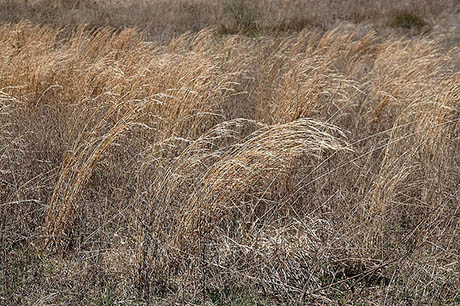
IMAGE: “Do Not Move Banana Plants” signs are a common roadside sight in Queensland, Australia. Plant movement restrictions are enforced to stop the spread of plant pests and diseases, the export of rare or endangered species, and the import of non-native, potentially invasive species. Image courtesy Brian J. McMorrow.
A fascinating recent article in the New York Times managed to combine three of my favourite plant-related ideas (seed banks, the control of invasive species, and climate change as unpredictable landscape redesign engine) and then add a fourth that was new to me: assisted migration.
Under the Seeds for Success programme, jointly run by the U.S. Bureau of Land Management and Kew’s Millennium Seed Bank, scientists at the Chicago Botanic Garden have been sending expeditions out “across the Midwest and West to the Rocky Mountains and Great Basin,” according to journalist Anne Raver, on a mission to “collect seeds from different populations of 1,500 prairie species by 2010, and from 3,000 species by 2020.”
These seeds are then carefully documented, assessed, cleaned, and packaged before being consigned to the Dixon National Tallgrass Prairie Seed Bank in Chicago Botanic Garden’s brand new Rice Science Center, a “giant humidity-controlled freezer stabilized at minus 4 degrees Farenheit.” Depending on the species, seeds can be preserved there for at least a couple of decades, and sometimes for thousands of years.

IMAGE: Seeds being placed in cold storage at the Royal Botanic Garden Kew’s Millennium Seed Bank, courtesy RGB Kew.
Discussing the Rice Science Center on Chicago Public Radio, Kayri Havens, Director of Science and Conservation at the Garden, was at pains to stress that the purpose of the seed vault goes beyond creating an archival record:
The idea is that this is really a seed bank, not a seed morgue. Just like a bank, researchers not only deposit but withdraw seeds. About half the seeds are used for prairie restoration, and other seeds are used for research.
But restoring the fragile prairie ecology, both now and in the future, becomes much more complex when you factor in the effects of climate change. In other words, while Chicago Botanic Garden scientists are carefully collecting the seeds of indigenous prairie plants, those species will almost certainly not be suited to future, warmer conditions in the region. “Some models show us with a more Virginia-like ecosystem,” Dr. Havens told the Times, while “some say more like Texas.”

IMAGE: Map showing the impact of a 4ºC (7ºF) rise in the global average temperature, produced by the Met Office’s Hadley Centre. For the full size interactive version, click here.
This is where the idea of assisted migration comes in. According to Michelle Nijhuis, who described efforts to relocate the Florida torreya tree for Orion Magazine (found in The Best American Science and Nature Writing 2009), the term was coined a graduate student, Brian Keel, in 2004. “It’s an easy idea to caricature,” she notes. “FedEx the polar bears to Antarctica! Airlift the pikas and the orchids! But some scientists take the concept very seriously.”
Plant species have always shifted their range in response to regional climate variability. The problem is that the old-school dispersal vectors – wind, insect pollinators, and bird or animal carriers – just can’t move them fast enough to keep pace with man-made climate change. Seed banks really do risk becoming morgues if a plant’s original habitat is long gone; while captive breeding programmes without hope of reintroduction are, in Nijhuis’ words, “an expensive and indefinite custodial project, an ark with no gangplank.”
In that context, assisted migration, or strategically shipping plants on ahead of themselves, begins to seem less and less of a crazy idea. Detractors point to our less-than-stellar track record with introducing species to new habitats (kudzu), as well as the inherent contingency built in to current predictions of the ways in which climate change will shape future habitats and interspecies relationships. Nonetheless, Dr. Havens and four of her Chicago Botanic Garden colleagues have recently co-authored a paper that, “while recognizing the potential negative impacts,” proposes a strategy for seed collection and banking that will facilitate future “purposeful human-mediated migration.”

IMAGE: Prairie Grass, Rock Springs Nature Center, Illinois. Photo by Robert Lawton, found via Wikimedia.
This means that decisions about which species to prioritise collecting for the Dixon National Tallgrass Prairie Seed Bank collection are being made in the context of these plants’ potential future homes, rather than their current living circumstances. Meanwhile, the Times reports, the garden is using some of the plant materials it collects to test the idea, by planting specimens at seven different “climate change gardens” around the United States:
Each garden contains genetically identical clones of plants grown from seed collected in four hardiness zones (4, 5, 6 and 7). Three sites are in the Chicago area, with the others in Boston; Chapel Hill, N.C.; Seattle; and Washington. Students and volunteers will collect data on the species, and can compare their gardens with others through a webcam system.
“If plants grown from seed collected in Zone 4, 5 or 6 can’t withstand Texas conditions,” Dr. Havens said, “that’s a good sign they’re going to become extinct here, if there’s no way for them to migrate on their own or human-assisted.”
It’s a radical idea: the scientists at Chicago Botanical Garden have determined that preserving the prairie ecology includes working out how to relocate it somewhere else altogether. Pati Vitt, a Conservation Scientist at the garden and one of the paper’s co-authers, told the Times reporter that, “I won’t be around in 100 years, but if the research isn’t there, we won’t know how to do it on that scale. That’s why the seed bank is so important.”
As Nijhuis points out, the implications of assisted migration directly contravene “the traditional conservation notion – call it an illusion, if you like – of a place to get back to.” For most people, the limits of landscape preservation stop at restoration – well short of wholesale redesign.

IMAGE: The USDA Plant Hardiness Zone Map (USDA Miscellaneous Publication No. 1475, Issued January 1990), published online by the U.S. National Arboretum. For the full size interactive version, click here.
The ambitions of Dr. Vitt and her colleagues don’t stop at relocating the prairie landscape, however. Their co-authored paper, “Assisted migration of plants: Changes in latitudes, changes in attitudes,” calls for globally agreed seed-banking and future-habitat-matching protocols. With a vision that rivals the space mirrors and artificial clouds of geo-engineering for sheer speculative wonder, Dr. Havens, Dr. Vitt, and their colleagues propose that plant conservationists around the world should be working as all-inclusive real estate agents, hunting down the next home for their clients before helping them pack up and move in.
The very concept of a globally coordinated effort to re-arrange the biosphere to match future landscapes is both terrifying and awe-inspiring – a sort of ecological Rubix Cube with the added complexity of soil, habitat, and climate variables. Meanwhile, just as in human home-buying, a break in the chain could lead to disaster: what happens if the Florida mangroves are planning to move to the Chesapeake Bay, but the Chesapeake Bay’s new home in the Long Island Sound is still occupied by its original ecosystem?

